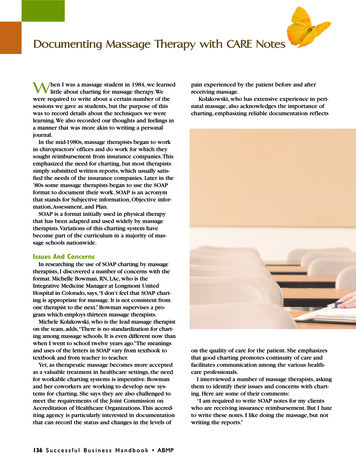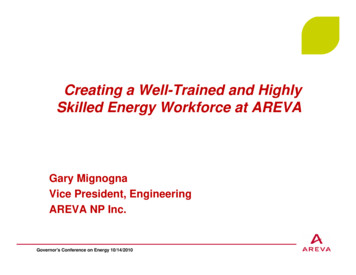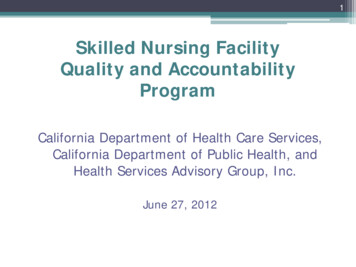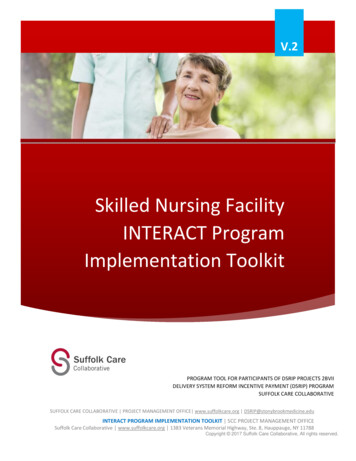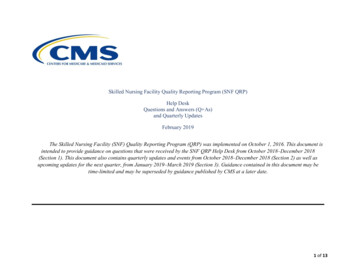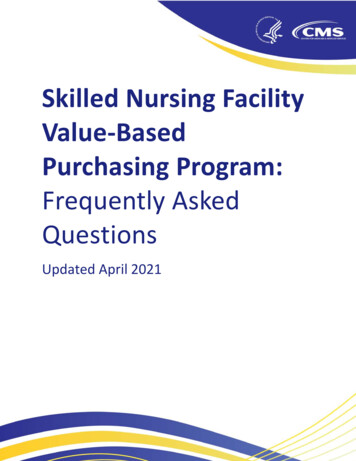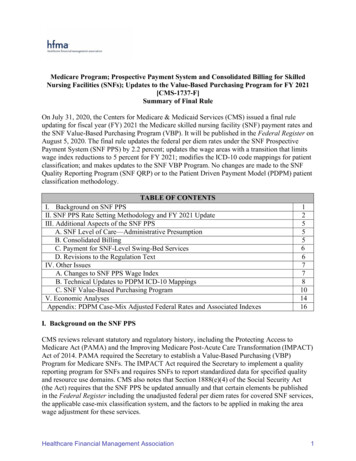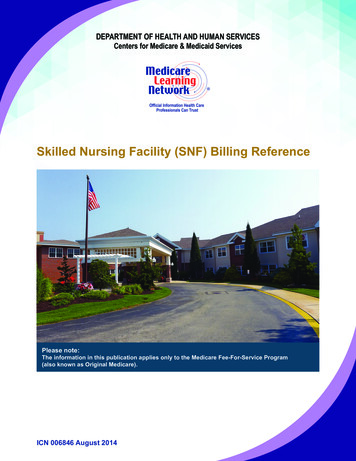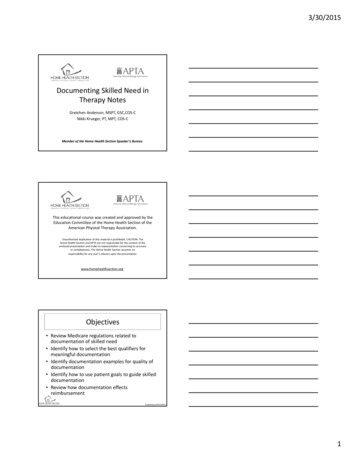
Transcription
3/30/2015Documenting Skilled Need inpy NotesTherapyGretchen Anderson, MSPT, GSC,COS‐CNikki Krueger, PT, MPT, COS‐CMember of the Home Health Section Speaker’s BureauThis educational course was created and approved by theEducation Committee of the Home Health Section of theAmerican Physical Therapy Association.Unauthorized duplication of this material is prohibited. CAUTION: TheHome Health Section and APTA are not responsible for the content of theenclosed presentation and make no representation concerning its accuracyor completeness. The Home Health Section assumes noresponsibility for any user’s reliance upon the presentation.www.homehealthsection.orgObjectives Review Medicare regulations related todocumentation of skilled need Identify how to select the best qualifiers formeaningful documentation Identify documentation examples for quality ofdocumentation Identify how to use patient goals to guide skilleddocumentation Review how documentation effectsreimbursementProprietary information1
3/30/2015Skilled Need: why’s it so important? Best Practice Compliance:– State surveys–CConditionsdi ioffParticipation review– Other surveyingbodies Reimbursement– ADRs– RAC audits– ZPIC audits– CERT audits– Face‐to‐Face review Litigation protectionTherapy is where the is, they are looking at us TOO!Proprietary informationSkilled Need: I document that, right? We know that to meet eligibility criteria forHome Health (HH), pt must be/have:– Homebound Status– Intermittent Needs– Reasonable and Necessary needs– Under the care of eligible MD– SKILLED NEEDMedicare Benefit Policy Manual – Chapter 7: Home Health www.cms.gov/regulationsandguidance ; accessed 1/20/14Proprietary informationSkilled Need: I document that, right? But once the pt is on service Does our documentation continue to supportskilled need for EVERY visit? Do you painti theh wholeh l pictureievery time?i ?Proprietary information2
3/30/2015Skilled Need: Is there a Guide?Proprietary informationSkilled Need: Regulations 7/40.2.1‐e “As is outlined in home health regulations, as part of the homehealth agency (HHA) Conditions of Participation (CoPs), the clinicalrecord of the patient must contain progress and clinical notes Assuch, it is expected that the home health records for every visit willreflect the need for the skilled medical care provided. These clinicalnotes are also expected to provide important communicationamong all members of the home care team regarding thedevelopment, course and outcomes of the skilled observations,assessments, treatment and training performed. Taken as a wholethen, the clinical notes are expected to tell the story of the patient’sachievement towards his/her goals as outlined in the Plan of Care.In this way, the notes will serve to demonstrate why a skilled serviceis needed.Medicare Benefit Policy Manual – Chapter 7: Home Health www.cms.gov/regulationsandguidance ; accessed 1/20/14Proprietary informationSkilled Need: Regulations Therefore the home health clinical notes mustdocument as appropriate:– the history and physical exam pertinent to the day’svisit inclincludingding the response or changes in behabehaviorior to prepreviouslyio sladministered skilled services– the skilled services applied on the current visit– the patient/caregiver’s immediate response to theskilled services provided– the plan for the next visit based on the rationale ofprior results.Medicare Benefit Policy Manual – Chapter 7: Home Health www.cms.gov/regulationsandguidance ; accessed 1/20/14Proprietary information3
3/30/2015Skilled Need: Regulations “Clinical notes should be written such that theyadequately describe the reaction of a patient to his/herskilled care. Clinical notes should also provide a clearpicture of the treatment, as well as “next steps” to betaken. Vagueg or subjectivejdescriptionspoff the patient’spcare should not be used.” “For example terminology such as the following wouldNOT ADEQUATELY describe the need for skilled care:– Patient tolerated treatment well– Caregiver instructed in medication management– Continue with POC”Medicare Benefit Policy Manual – Chapter 7: Home Health www.cms.gov/regulationsandguidance ; accessed 1/20/14Proprietary informationSkilled Need: Regulations “Objective measurements of physical outcomes oftreatment should be provided and/or a clear description ofthe changed behaviors due to education programs shouldbe recorded in order that all concerned can follow theresults of the applied services.” “WhenWhen the skilled service is being provided to eithermaintain the patient’s condition or prevent or slow furtherdeterioration, the clinical notes must also describe:– A detailed rationale that explains the need for the skilled servicein light of the patient’s overall medical condition andexperiences,– the complexity of the service to be performed, and– any other pertinent characteristics of the beneficiary or home.”Medicare Benefit Policy Manual – Chapter 7: Home Health www.cms.gov/regulationsandguidance ; accessed 1/20/14Proprietary informationWhat does this mean for me? Every visit – not JUST the admit/eval– Document on objective test/measures related to afunctional patient goal– Document how the patient needed a therapist vs afamily member/other caregiver– Document how the pt responded to my SKILLEDteaching/training immediately and how that effectsthe pt’s functional outcomes– Document the plan for the next visit and/or theprogress towards goal, therefore discharge.– Avoid vague references that mean nothing!Medicare Benefit Policy Manual – Chapter 7: Home Health www.cms.gov/regulationsandguidance ; accessed 1/20/14Proprietary information4
3/30/2015Now you know the SECRET!Let’s break it down! Therapeutic Exercise ROM Gait /Transfer Training ModalitiesProprietary informationPT Evaluation for THR PT admit: L THR Strength: R LE: 5/5; L HIP FLEX: 3/5; HIP ABD:NT; HIP ADD: 3/5;KNEE EXT: 4/5; ANKLE DF: 5/5 Strength Goals: INCREASE STRENGTH TO L LE BY 1/3 GRADE BYDISCHARGE Treatment:– PATIENT HAS A WRITTEN HEP FROM HOSPITAL, MADE ADJUSTMENTS ONHEP FOR PATIENT;– SUPINE EXS QUAD AND GLUT SETS X 10; HEEL SLIDES, SAQ, IR/ER, PASSIVEHIP ABD AND ACTIVE HIP ADD, LAQ X 10 WITH L LE;– STANDING TOE RISES, MARCHING IN PLACE, HIP EXT AND HAMSTRINGCURLS X 10 WHILE HOLDING ONTO WALKER FOR SUPPORT.– INSTRUCTED TO DO EXS 2X/DAILY;– CRYOTHERAPY TO L HIP X 20 MINS WHILE SUPINE WITH L LE ELEVATED TOHELP WITH SWELLING.Proprietary information5
3/30/2015PT Evaluation for THR Assessment: “PATIENT TOLERATED RX WELL,RELIEVED THAT SHE DID NOT HAVE TO DO 30REPS WITH EXS, STATES IT WAS REALLY HARDYESTERDAY WHEN SHE DID IT WITH HUSBANDYESTERDAY.” Plan: “PLAN TO SEE PATIENT TIW INITIALLYFOR GAIT AND EXS; PROGRESS ASTOLERATED”Proprietary informationWhat are the Learning Opportunities? Strength:– MMT is objective testing,– What about UE for proper use of A.D.? Goal:– Is it SKILLED to do strengthening exercise just to increasestrength? NO How do you measure a 1/3 muscle grade?– Where is the FUNCTIONAL component that makes thisskilled? What are the pt’s goal? Does that make this goal functional?Proprietary informationWhat are the Learning Opportunities? Treatment:– Just listed exercise, could an aide/caregiver have donethis treatment? Was there verbal or tactile cues for proper recruitment Maybe pt able to do 10 reps of QSQS, GSGS, APAP, but only 8 repsof HS due to compensation– Cryotherapy – where was the skill? 20 min unless you see s/s of – Why did a PT license need to be in the home insteadof an aide? Or the family just doing the HEP from thehospital?Proprietary information6
3/30/2015What are the Learning Opportunities? Assessment:– Did it give you any valuable information? NO HHow did ththe ptt respondd tto ththe cueing?i ? What are the pt’s deficits What does the pt need to be able to perform inhome– This is why pt needs Skilled HHPTProprietary informationWhat are the Learning Opportunities? Plan:– Did it give you any valuable information? TIW is good “.for gait/exer. Progress as Tolerated” Does that tell usmuch?h? NO– What are you going to gait train with?– What type of exercise?– What functional and patient goals are you goingto work towards?Proprietary informationSo let’s do a re‐write Strength: R LE: 5/5; L HIP FLEX: 3/5; HIPABD:NT; HIP ADD: 3/5; KNEE EXT: 4/5; ANKLEDF: 5/5; BUE 4 /5 Strength Goals: INCREASE STRENGTH TO L LEto 4 /5 BY DISCHARGE IN ORDER TOTRANSITION SAFELY TO AMB WITHOUTA.D. WHILE PROTECTING NEWPROSTHESISProprietary information7
3/30/2015So let’s try Take‐2 Treatment: patient has a written HEP from hospital, madeadjustments on hep for patient; supine exs quad and glut sets x 10;heel slides, saq, ir/er, TACTILE CUES WITH QS/HS/SAQFOR QUAD RECRUITMENT, ONLY ABLE TOREPRODUCE 50% OF TIME WITHOUT CUES; passive hipabd and active hipp add,, laqq x 10 with l le;; standingg toe rises,,marching in place, hip ext and hamstring curls x 10 while holdingonto walker for support; MAX V.C. FOR PROPERTECHNIQUE AND NO COMPENSATION ONHIPEXT/HAM CURLS. instructed to do exs 2x/daily;cryotherapy to l hip x 20 mins while supine with l le elevated to helpwith swelling; PT INSTRUCTED TO DISCONTINUE ICE IFNOTES NON‐BLANCHABLE REDNESS/BLISTERSProprietary informationSo let’s try Take‐2 Assessment: PATIENT UNABLE TO TOLERATEMORE THAN 10 REPS OF THE EXER BEFOREBEGINS TO COMPENSATE; EVEN w/10 REPS,PT REQUIRED, VERBAL/TACTILE CUES FORPROPER TECHNIQUE AND QUADRECRUITMENT; UNABLE TO SUSTAINRECRUITMENT WITHOUT CUEING; WILLBENEFIT FROM FURTHER SKILLED HHPT FORTHER EX TO WORK ON STRENGTH OFAFFECTED LE. (PLUS “XYZ”)Proprietary informationSo let’s try Take‐2 Plan: PLAN TO SEE PATIENT TIW INITIALLYFOR GAIT AND EXS; WILL PROGRESS EXERPROGRAM, GAIT/TRANSFER TRAINING ASAPPROPRIATE TO RETURN PT TO PRIOR LEVELOF FUNCTION OF (I) WITH ALL TRANSFERSAND WALKING WITHOUT USING A.D. ONEVEN/UNEVEN SURFACE AND 8 STEPS TOENTER/EXIT HOME.Proprietary information8
3/30/2015How do you start?How do you start?RoutineVisits‐30 day FunctionalReassessments‐Re‐eval POC, D/CplanningFunctional, Objective, andMeasurable GoalsDevelop POC, D/C planningJust like anything else – Start with a goodfoundation!Proprietary informationHow to write solid goals? When writing goals, remember to be objectiveand measurable but above all, beFUNCTIONAL Be CLEAR about what we are trying toaccomplish Document towards a goal(s) on EACHROUTINE VISIT, not just eval and re‐assessmentsProprietary information9
3/30/2015Let’s Try a Few Examples! Pt to walk again. Pt able to amb safely household distances Pt to amb 1000’ safely and independentlywith 4WW to enable them to safely go tomeals and activities in facility.Proprietary informationLet’s Try a few Examples? Pt to increase R knee ROM by 10 degrees Pt to have 90 degrees AROM R kneeby dischargedischarge. Pt to achieve 105 degrees AROM in 3 weeksto tolerate car transfer in low car for MDappointment and 120 degrees by 6 weeks perMD protocol of maximum ROM.Proprietary informationOne More Pt to have a home program Pt to be (I) with HP by discharge Pt able to teach back use of ice/AP/elevation tocombat pain/edema/DVT in 2 visits. Pt to demo (I) with R TKR supine exer programin 2 visits, seated program in 4 visits andstanding program in 6 visits.Proprietary information10
3/30/2015Documenting Progress in Daily Notes Document progress toward goals in objectiveterms/measurements– Evidence based when possible ANDAND, what does that mean functionally for pt?– “Pt can now perform bed mobility independently sincequad/abd strength is increased”– “Pt can now tolerate sitting for 10‐15 minutes with VSS forsponge bath performed by CG”– “Pt able to amb 65’ on level ground, with SPC and SBA, halfthe distance to the mailbox, before circumductioncompensation begins.”Proprietary informationDocumenting Progress in Daily Notes Examples:– Pt with COPD– PT who has had a stroke– Any others you are having difficulty with? It starts with you GOALS!!!Proprietary informationUh Oh I can’t put “Not met” What happens if we don’t meet our goals?– NOTHING!– The world does not come to an end Another Documentation Challenge:– What if not meeting goals?– Can you justify continued therapy?Proprietary information11
3/30/2015Documenting Lack of Progress What should you do?– First, make sure your goals are appropriate: Set goals that are functionalGoal should be reasonable for conditionGoals should be patient‐based and patient‐centered.Goals should be referred to often in dailydocumentationProprietary informationDocumenting Lack of Progress Document why goals not being met?– Medical conditions impacting patient progress—development of UTI or other illnesses– Social factors impeding progress—this isexplainable but not if it isn’t documented!– Perhaps pt. isn’t responding as you hadhoped/predicted. It’s ok to state this, but you have to show change in POC Change of focus/approach with treatment Change of clinician, if indicatedProprietary informationPt is progressing well.but needs more! When might this be?– Anytime!!! Okay to modify goals/advance them— justmakea e suresu e itt iss documented!docu e ted! Focus on quality of their movement/mobility– Perhaps they can walk with the cane in theirhome but it is unsafe to do so on their own– Maybe they can do the TUG in less than 14seconds but are impulsiveProprietary information12
3/30/2015Pt is progressing.but needs more! Focus on areas of concern or part of the goal NOTbeing achieved– “Although pt has met goal of independent ambulationin the home, the patient continues to have dyspneathat is limiting functional activity tolerance andincreasing risk of falls”– “Patient is now pain free but quality of gait is poorand patient is a fall risk due to this. With continuedfocus on heel strike and gait pattern, the patientshould reach the point where he is safe in his ownhome with device.”Proprietary informationReview: Why is this discussionimportant?
Therapy Notes Gretchen Anderson, MSPT, GSC,COS‐C Nikki Krueger, PT, MPT, COS‐C Member of the Home Health Section Speaker’s Bureau This educational course was created and approved by the Education Committee of the Home Health Section of the American Physical Therapy Association.
